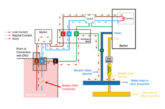
Keith Willcock, Product Manager for Siemens Alpha Circuit Protection Products, reviews the implications for designers and installers of electrical installations from the latest requirements for additional protection for socket outlets in BS 7671, including Amendment 2.
Regulation 411.3.3 Within Chapter 41 (protection against electric shock) Regulation 411.3.3 now tells us:
‘.. in AC systems additional protection, by use of a 30mA residual current device, must be provided for socket outlets (not rated higher than 32 A) in locations where those socket outlets are likley to be used by persons of capabilty BA1, BA2 & BA3. There are no exceptions to this requirement.’
Previously this regulation did not overtly consider user capability. The regulation concerned itself with the equipment type i.e. socket outlets. Now the person using the socket outlets is the principal consideration for designers and installers.
What are BA1, BA2 & BA3?
The terms BA1, BA2 & BA3 are explained in BS 7671 Appendix 5 of the Wiring Regulations, which includes a list of external influences, and, in table B, under the sub heading of ‘Utilization’ BA, refers to the capability of persons. BA1 is described as an ordinary person (a person who is neither a skilled person nor an instructed person), BA2 as children, and BA3 as disabled persons.
Which locations are included?
Regulation 411.3.3 does not give a list of typical locations, so designers and installers have to determine for themselves which locations include socket outlets that are liable to be used by ordinary persons, children or disabled persons. Typical obvious locations will include schools, universities, offices, factories, hospitals, nurseries, care homes, hotels, and indoor/outdoor locations. Actually, its hard to exclude any locations, the requirement really means all workplaces, all leisure facilities, and all living accommodation. No exceptions permitted.
What is a socket outlet?
People probably imagine a common BS 1363, 13 A, three pin socket outlet when they read Regulation 411.3.3, but the regulation isn’t limited to 13 A sockets – it includes all types of socket outlets up to a maximum rating of 32 A.
The regulations state that a socket outlet is a device, provided with contacts, which is intended to be installed with the fixed wiring, and intended to receive a plug.
Taking account of all the types of premises with the relevant locations covered by this regulation there will be a wide variety of socket outlets that must have additional protection by a 30mA residual current device, including 2, 5, 13, 15, 16, 20 and 32 A round pin, square pin, fused or unfused indoor or outdoor sockets.
What is the solution?
The simplest compliant solution is to use an individual Type A 30mA RCBO on each circuit that supplies power to any socket outlet. This will meet the requirement for additional protection, avoid unwanted tripping, and maintain power continuity on healthy circuits.
Type A RCBOs are suitable for circuits with equipment incorporating electronic components that may produce DC currents; such equipment is commonplace in modern installations. Type A RCBOs are designed to trip on alternating sinusoidal residual current and on residual pulsating direct current.
MCBs won’t meet the requirements of BS 7671 for additional protection and shouldn’t be utilised for the circuits that supply socket outlets which will be used by ordinary persons, children or disabled persons.
Footnote:
Designers should not group several socket circuits on a single 30mA residual current device as this can actually cause unwanted/nuisance power outages to healthy circuits that share an RCD with a faulty circuit, and is very unlikely to comply with the wider requirements of BS 7671: Chapters 13 & 31, Regulations 531.3.2 etc
Browse Electrium’s Amendment 2 support page here








